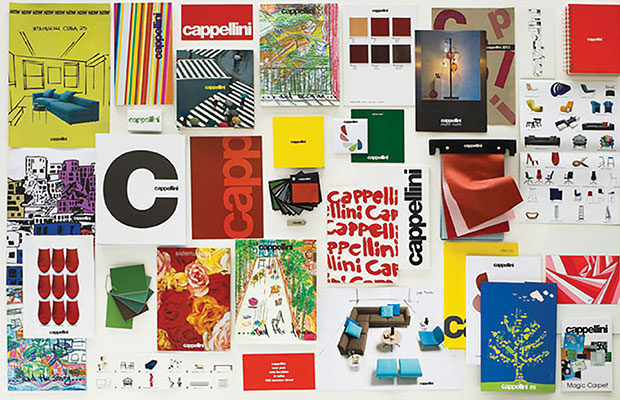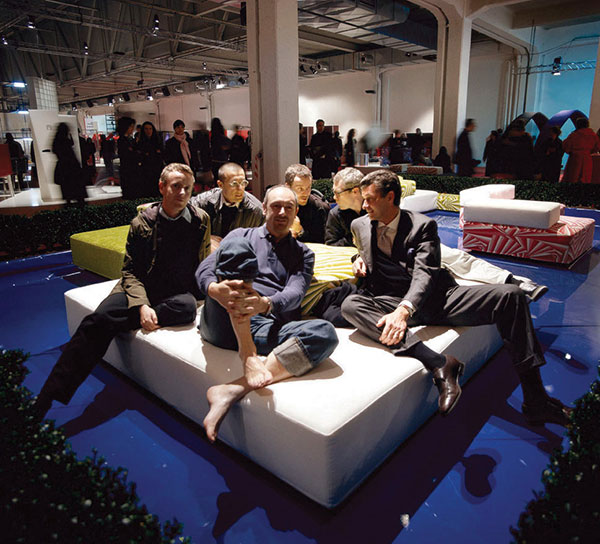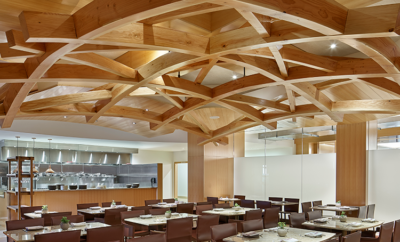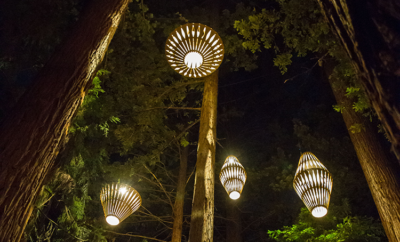 One of Cappellini’s marketing materials, with covers of the company’s catalogues as well as some of its fabric and lacquer swatches. | COURTESY CAPPELINI
One of Cappellini’s marketing materials, with covers of the company’s catalogues as well as some of its fabric and lacquer swatches. | COURTESY CAPPELINI
Design
Talent Scout
A NEW BOOK, THE CAPPELLINI METHOD. A PERFORMING DREAM by Francesca Serrazanetti, casts an unorthodox, but largely rewarding look at Giulio Cappellini, providing a jumping off point for surveying the work and impact of one of the most significant figures in the world of contemporary design of the last four decades. The scope of Cappellini’s influence cannot be understated. He has been widely hailed for his keen eye for discovering new talent, helping to launch the careers of more than fifty designers, including Nendo, Jasper Morrison, and Marcel Wanders, to name just a few. Many of the pieces he commissioned have found their way to the secondary market, selling for high prices both on the auction block and through dealers. Wanders’s Knotted chair, Marc Newson’s Wood chair, Fabio Novembre’s ORG table, and the Solaris chest by Shirō Kuramata are a few of his greatest hits.
From his youth, Cappellini had wanted to become an architect. He received a degree from the school of architecture at Milan’s Politecnico and interned for a year at the office of Gio Ponti. But then he decided that he would go into the family business, a furniture company that produced mostly traditional designs, with the intention of revolutionizing its direction. He began to work there in 1979, and in the course of time turned the firm into one of the most innovative and trendsetting manufacturers in the world.
Early on he brought in Rodolfo Dordoni, a friend from architecture school and today a celebrated designer, to help create the furniture that put the company on its modern path. He also designed many highly regarded pieces himself, which he has continued to do throughout his career. Then he became bolder, reaching out to non-Italians such as Morrison, Tom Dixon, and Newson—an audacious act at the time, for in the 1980s Salone del Mobile was totally ruled by Italian companies and Italian designers. Indeed, the fair was started in 1961 to promote Italian design, and so-called international companies could only exhibit every other year and struggled to get prime spaces on the exposition’s floors. By opening the door to two Englishmen and an Australian, Cappellini was instrumental in turning Milan from a national into an international event.
The book is organized as an almost A-to-Z (it ends at W) that relates the major events of Cappellini’s professional life by topic. Thus, the text starts at A, charting Cappellini’s beginnings as an architectural student and ends with the tale of his discovery of Marcel Wanders and Wanders’s subsequent production of the Knotted chair, now considered a seminal piece of design history.
In between, Serrazanetti explores Cappellini’s many accomplishments, including his collaboration with the great Japanese designer, Shirō Kuramata, which resulted in such now famous pieces as the Revolving cabinet and the sensuous Progetti Compiuti chest of drawers. Cappellini’s deep and abiding passion for art is also chronicled. With Romeo Gigli and Carla Sozzani, he staged a series of exhibitions called Cappellini Art in the late 1980s that featured work by artists Kim MacConnel, Izhar Patkin, and Kris Ruhs, who also created products for the company. In 1987 he formed Mondo, a division that celebrates craft, bringing handwork to the previously industrialized perfectionism of Italian furniture companies. His initial collaborations with Paola Navone for Mondo changed the course of design in the ’90s, pushing it in a more romantic direction, away from strict minimalism to a joyous celebration of the human touch. Navone’s reinterpretation of products from the Middle East, Far East, and Africa—Chinese furniture with a modern twist, wicker and rattan chairs with bold new silhouettes, and wrought iron bent to new modern purposes—took the crafts of these cultures beyond their niche ethnic labels.
Cappellini’s broader influence is less celebrated. By collaborating with non-Italian designers he brought true internationalism to what had previously only been given lip service. He has also served as an inspiration for a new generation of manufacturers. Mette and Rolf Hay worked for Cappellini’s Danish distributor and were so inspired by him that the couple decided to go into business for themselves. “We wanted to bring the excitement he created to a more affordable level,” Mette Hay said at this year’s Salone. (Hay just announced a partnership with IKEA, bringing their less pricey approach to a new mass audience.)
The book also spotlights Cappellini’s major role in expanding the world of Salone del Mobile to the entire city, when, in 2000, he moved from the fairgrounds to an old industrial facility— Superstudio in Zona Tortona, then a part of the city mostly populated with empty warehouses. Cappellini proceeded to fill the first floor— a 27,000-square-foot space—with projects by forty designers, giving each his or her own spotlight. The neighborhood became a must-visit destination overnight.
Until that time very little happened outside the fairgrounds itself, with just a smattering of special exhibitions staged around town. Today, under the rubric “Fuorisalone” (Outside Salone), there are seven districts and almost four hundred events taking place all over the city. Cappellini continued to stage trendsetting exhibitions in Zona Tortona until 2004, when his company was acquired by Charme, an Italian conglomerate, and folded into a group under the Poltrona Frau umbrella. In 2014 Poltrona Frau was acquired by Haworth, the North American contract furniture company, where Cappellini still reigns as creative director of the Cappellini division.
Of course, the book celebrates Cappellini’s unerring eye for new talent. Besides those already mentioned, the list of designers he has collaborated with over the years includes the Bouroullec brothers (Erwan and Ronan), Patrick Norguet, James Irvine, Karim Rashid, Ross Lovegrove, Todd Bracher, and Konstantin Grcic. But overlooked is the boost Cappellini has given to some American designers: Jeffrey Bernett, Stephen Burks, and the late Lloyd Schwann owed much of their success to his initial championing.
Cappellini gracefully acknowledges his role as talent scout and continues to have warm relations with many of his protégés. He thinks it would be fun to gather all of them in one place for a celebration. “I am trying to organize all the people on Lake Como,” he says. “But it’s hard to corral 40 or 50 people.” The handsome, always dapper Milanese is often asked what he looks for in new designers and how he spots great work. “It’s a sense of the designer,” he says. “It comes from my stomach.”
Today he travels extensively, visiting design schools, museum exhibitions, and trade shows all around the world. At SaloneSatellite, a part of Salone del Mobile that has presented the work of unknown young designers for nineteen years and has been a launching pad for many careers, exhibitors regard Cappellini with reverential awe. When he walks through the hall, he is treated like visiting royalty, each person hoping to be tapped as his latest find. At Haworth he is still creating products himself, working on new showrooms, graphic materials, and exhibitions— the list is endless. “One life is not enough,” he says. “I work more than before.”

Giulio Cappellini with some of his protégés at Superstudio during Salone del Mobile in Milan in 2001, moving clockwise: Piero Lissoni, Ronan Bouroullec, Carlo Colombo, Erwan Bouroullec, and Jasper Morrison.| COURTESY CAPPELINI












